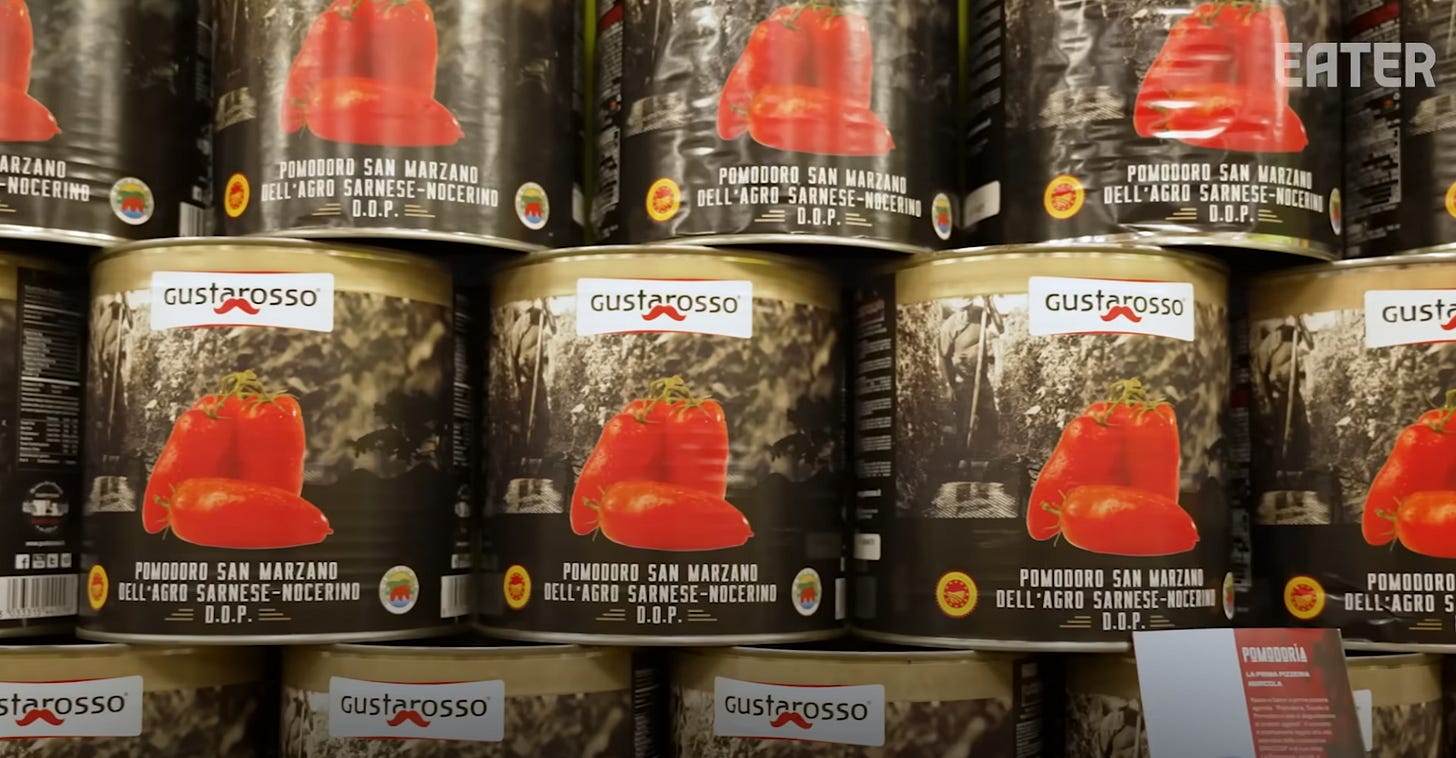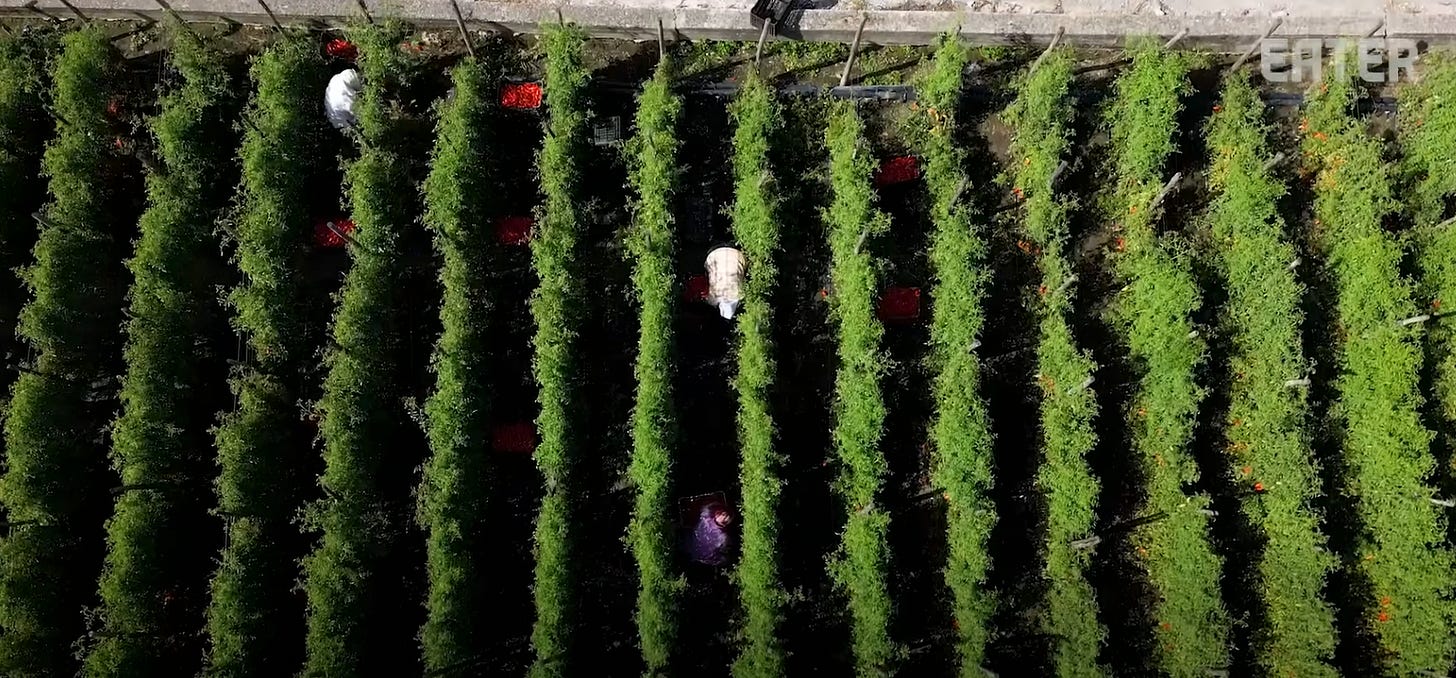The world's most famous tomato
Why the San Marzano is worth talking about 🍅🥫
The boiling days of August are upon us and few are enjoying the heat – possibly least of all the tomato pickers in Sarno, a patchwork of industrial buildings and small fields tucked behind Mount Vesuvius in Italy’s Campania region. One of the few living things that can thrive in these conditions are the tomatoes themselves, oblong and plump, turning deliciously red thanks to the sun’s relentless beating.
The tomato pickers don wide-brimmed hats, long sleeves, and gloves as they begin their work around 6 a.m. Most of them are in their 80s and will stop around noon when conditions become unbearable. They sing old Italian songs to pass the time as they kneel on the ground carefully plucking the first ripe tomatoes from the bottom of the vines. The green ones higher up will slowly mature over the next few weeks.
Not all Italian tomatoes receive such attentive care, but that’s because not all tomatoes are San Marzano. This unique variety is highly revered among chefs and pizzaioli around the world for its sweetness and depth of flavor, complimented by just a touch of acidity. In the Neapolitan tradition, a can of whole San Marzano tomatoes crushed by hand and mixed with a pinch of salt is all that’s needed for a pizza sauce that perfectly balances the fatty creaminess of buffalo-milk mozzarella and the peppery bite of fresh basil leaves.
Although one of the region’s proud farmers told me that the San Marzano is as old as the land itself, that’s not exactly the case. In fact, the tomato, now a ubiquitous icon of Italian cuisine, has only been consumed in the country for the past 200 years.
Native to Central and South America, tomatoes were brought to the Old World in the 16th century by returning Spanish conquistadors. At first, Europeans didn’t dare eat the fruit since the leaves resembled the poisonous nightshade plant. Instead, they were grown for decorative purposes until the 1800s when they found their way into the Mediterranean cuisine of Spain, France, and Italy.
There are several legends purporting to explain the origin of the San Marzano tomato, but historic evidence suggests it was first cultivated in the 1770s in the village of San Marzano sul Sarno, a stone’s throw from the ruins of Pompeii. The volcanic soil, abundant water sources, and iodized breeze blowing off the Tyrrhenian Sea allowed the tomato – and subsequently the local economy – to flourish.
Today, only tomatoes cultivated, harvested, and canned in this remarkably tiny geographic area are allowed to be labeled as San Marzano thanks to the Protected Designation of Origin certification awarded by the European Union in 1996.
That doesn’t stop counterfeit products from being produced, however. Around the world, cans labeled as San Marzano-style, Italian-style, or more brazenly, simply San Marzano try to capitalize on the glory of the real deal.

That’s why Nunzia Pino Adiletta takes extra care to check each crate of tomatoes delivered to her family’s canning facility in Sarno, where freshly picked San Marzanos are delivered in the morning and stored in the warehouse by evening. She picks up a bright red tomato warm from the sun and inspects the shape – long and thin with a distinct point at the tip. Then she breaks it open with her fingers to check for the veins just under the skin along with the thick, white filaments which run through the center – telltale signs of a real San Marzano.
The canning process is simple yet meticulous. According to Italian regulation, a tomato can only be labeled San Marzano if it is of the right variety, whole, peeled, and canned – no diced products or sauces allowed.
In Nunzia’s processing facility, the tomatoes are washed twice before being passed through a steam peeling machine. The peeled tomatoes drop onto a conveyor belt where rows of nimble hands pick out any slightly green, misshapen, or poorly peeled tomatoes that don’t conform to the specifications of the law. They’re dropped down a tube to be cooked and blended for the sauce that fills the San Marzano cans, which come in two sizes: three kilos and 500 grams. I get a kick out of Nunzia’s description of the food service size as suitable for large families and the regular can being a “single portion.”
Although – or maybe because – Nunzia has grown up surrounded by these tomatoes, she’s remarkably passionate about them. When we retreat to her office to escape the sputtering machinery of the factory floor, she grabs a can of tomatoes off her desk and points out that the expiration date was technically two years ago. Then she pops it open, pours the tomatoes onto a paper plate, and puts one in her mouth. Not only has it not gone bad, she explains, the flavor is as intense as the day it was harvested.
I try one for myself. Although I’ve been learning about these tomatoes for two days, it’s the first time I’m tasting one that hasn’t been incorporated into pizza or pasta. The flavor is unlike any tomato I’ve tasted before. It’s fresh and bright – a perfect balance of sweetness and acidity. If I could only choose one tomato to eat for the rest of my life, it’d be the San Marzano, ripened in the sun and picked by the wrinkled hands of grandmothers in the shadow of Vesuvius.







Thanks for the history of San Marzano tomatoes. I only discovered them during the pandemic and in sauces now only use them. They are head and shoulders so much better than any other canned tomato. Grazi!
There is absolutely nothing like a fresh tomato that actually tastes like a tomato…